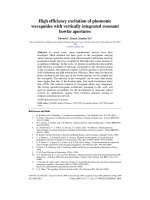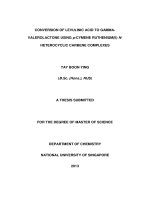High efficiency conversion of CO2 to methanol using photoelectrocatalyst
Bạn đang xem bản rút gọn của tài liệu. Xem và tải ngay bản đầy đủ của tài liệu tại đây (1.68 MB, 20 trang )
High-efficiency conversion of
CO2 to methanol using
photoelectrocatalyst
•
•
•
•
Reporter : Tran Thanh Phuc
Class
: CHHO7B
Lecturer : Luu Cam Loc
Report date : March 23, 2019
Outline
• Introduction
• Methanol yield
• Conclusion
2
Introduction
High temperature and
high pressure
300°C and 500 bar
Using
catalyst
Introduction
Introduction
Introduction
Photocatalytic
PC
The presence of light
Activating a catalyst
by ultraviolet (UV) or
visible light
Semiconductor materials,
which can form electrons and
holes when exposed to light
The reactions are
normally either oxidation
or reduction
Introduction
Photocatalytic
PC
An ideal photocatalyst should have the following
properties
Introduction
Introduction
Photocatalytic
PC
Under ambient temperature and pressure driven by
solar energy
The PC conversion efficiency of CO2 to methanol
(CH3OH) is generally low.
Under ambient temperature and pressure
Electrocatalytic
EC
Low energetic efficiency, and poor selectivity.
Introduction
Matches the energy
band for PC
reduction
Matches the small
overpotential for EC
reduction
Photoelectrocatalytic
(PEC)
Cu2O/Fe2O3 NTs
Introduction
Fe2O3 (iron oxide)
Structure and
properties
Transition metal oxide
wüstite
(FeO)
hematite (Fe2O3)
maghemite
(-Fe2O3)
magnetite
(Fe3O4)
n-type semiconductor
Narrow band gap (2.0–2.2 eV)
Absorbs light up to 600 nm
The stability in most aqueous solutions (pH > 3)
The cheapest semiconductor
Introduction
Fe2O3 (iron oxide)
-Fe2O3
nanotubes
(NTs)
large surface
areas
could reduce the
electron–hole pairs
recombination
Conduction band: 0.28 eV
nanotubes have
higher PC activity
Valence band: 2.48 eV
The reduction of Fe2O3 is very weak for the positive conduction band
Cuprous oxide (Cu2O) was selected to couple with Fe2O3 NTs
Introduction
The p-type semiconductors
Cuprous oxide (Cu2O)
Low toxicity, low cost, earth
abundant properties
The CB of Cu2O is more negative than the CO2 reduction potential
and the band gap is relatively narrow (1.9–2.2 eV).
Conduction band: -1.3 eV
Serious photocorrosion of Cu2O in aqueous solution.
Photocorrosion
Photocorrosion of
of the
the photocathode
photocathode will
will greatly
greatly decline
decline
the
the overall
overall reduction
reduction efficiency
efficiency since
since most
most
photogenerated
photogenerated holes
holes are
are consumed
consumed by
by Cu
Cu22O
O itself.
itself.
Introduction
Cu2O/Fe2O3 NTs
The material with double-layer Cu2O spheres (Cu2O/Fe2O3 NTs-30)
showed excellent PEC properties with a suitable energy band gap
(1.96 eV) and the smallest over-potential (180 mV).
Valence band: 1.09 eV
Conduction band: -0.87 eV
Introduction
Cu2O/Fe2O3 NTs
A
CO2 in
V
Gas out
to GC
Light
(Xenon lamp)
Cu2O/Fe2O3 NTs-30
ref
Counter electrode
Methanol yield
4.94
2.29
1.39
0.90
Methanol yield of the PEC,PC, and EC reduction of CO2 on Cu2O/Fe2O3 NTs-30
Compared to EC or PC, the Cu2O/Fe2O3 NTs showed superior PEC
reduction performance for the efficient conversion of CO2 to CH3OH.
Mechanism
CB
VB
Cu2O/Fe2O3 NTs + h Cu2O/Fe2O3 NTs (h+ + e-)
H2O +2h+ 0.5O2 +2H+ +2eCO2 + 6H+ +6e- CH3OH + H2O
Comparison
Conclusion
The material with double-layer Cu2O spheres (Cu2O/Fe2O3 NTs-30) showed
excellent PEC properties with a suitable energy band gap (1.96 eV) and
the smallest overpotential (180 mV)
Cu2O/Fe2O3 NTs-30 showed two types of synergism in the PEC reduction
of CO2: (i) between electrocatalysis and photocatalysis and (ii) between
Cu2O and Fe2O3-NTs.
The faradaic efficiency and methanol yield reached 93% and 4.94 mmol L-1
cm-2 after 6 h, respectively
The excellent performance of Cu2O/Fe2O3 NTs-30 for the PEC reduction of
CO2 was well confirmed
Still used
external
voltage









